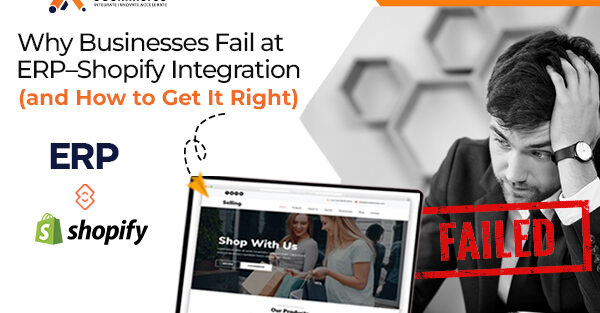
At face value, integrating Shopify with an enterprise resource planning system such as Microsoft Dynamics 365 Business Central seems straightforward: hook up your sales channel with your back office and let the data flow. The sad fact is that most businesses stumble: orders go missing, inventory is unreliable, and teams revert to manual fixes a few months from launch. The thing is, ERP-Shopify integration failures are never about technology alone; they are about strategy, scope, and execution. In this article, we discuss the most common reasons why ERP-Shopify integrations fail and how it can be done right by having the right approach and partner.
1. Treating Integration as a One-Time Project
For most companies, integration is one of those “set it and forget it” implementation tasks. In practice, however, integration is something that evolves over time, and you must align it to business growth and operational change.
- When integration is treated as a one-off project:
- Workflows break as order volumes grow.
- Sync errors due to new Shopify features or ERP updates.
- Teams lose visibility into system dependencies.
How to Get It Right:
Your integration is a living system, not a static tool. Select a scalable connector and a partner that will support, update, and maintain versions as your business evolves-which is what x2xeCommerce does.
2. Poor Data Mapping and Process Understanding
Integration not only involves data synchronization but also involves aligning business logics. Most failures occur due to mismatches in the data model set up at Shopify with those at ERP levels.
For example,
That would mean that one “customer” in Shopify can represent multiple billing entities in ERP.
Shopify Discounts or Bundles may not map correctly to ERP item structures.
Fulfillment workflows differ between stores or regions.
How to Get It Right:
Document in detail how orders, customers, items, and pricing flow across systems with deep process discovery. A good integration partner should provide clear data mapping and handle exceptions through configurable logic, not custom code.
3. Disregarding Business Rules and Exceptions
Many of those out-of-the-box integrations will inevitably fail to account for real-world complexities: preorders, backorders, partial shipments, or tax exceptions. These gaps force teams to handle exceptions manually-which defeats the purpose of automation.
How to Get It Right:
Provide a solution that allows for flexibility in business rules, conditional workflows, automated error handling, and rule-based order routing.
4. Lack of Real-time Sync and Visibility
Not all integrations are real-time, and some sync in intervals: for example, every 15 minutes or at an hourly rate. In fast-paced e-commerce, this could be enough to cause overselling, delays in fulfillment, or incorrect inventory counts.
How to Get It Right:
Choose between a real-time or near real-time integration, updating the most important data in real time: orders, payments, and stock levels. Your ERP should always reflect what happens in Shopify at this moment, not what happened an hour ago.
5. Over-customization without strategy
Bespoke integrations start off great but then become a real pain to maintain. Every time Shopify or your ERP updates, your custom code breaks, causing costly rework and downtime.
How to Get It Right:
Adopt an integration framework that is designed to be flexible and not hard-coded. The modular architecture lets you perform customizations through settings, not through scripts, which keeps you agile and update ready.
6. Forgetting the People Behind the Process
However, even the best of technologies fails if your teams don’t understand it. When the sales, fulfillment, and finance teams are not trained on the new integrated workflows, errors can easily seep in, starting from duplicate entries to missed order updates.
How to Get It Right:
Include user adoption and training in your integration rollout. This means making sure each department understands how it affects their everyday process. Give them real-time dashboards for transparency.
7. Choosing the Wrong Integration Partner
Not all integration partners are created equal, and some focus solely on technical connectivity, not business outcomes. The result is a situation whereby your data moves, but your processes remain disconnected.
How to Get It Right:
Partner with an integrator who understands not only the Shopify ecosystem but also the ERP ecosystem and speaks the language of IT and operations. At x2xeCommerce, we combine eCommerce expertise with ERP functional knowledge to deliver integrations that improve performance-not just data flow.
8. No post-go-live optimization
Many of the integration issues become apparent only after launch-when the volume of transactions goes up or when new workflows are added. Unless proactively monitored, small sync issues start to cascade into major operational disruptions.
How to Get It Right:
Also, plan for a post-launch stabilization and optimization phase. Set up regular monitoring for transaction logs, exception reports, and API health. x2x provides post-go-live support to fine-tune your integration as real-world data flows in.
The x2xeCommerce Approach:
We don’t just connect platforms; we connect your operations, data, and teams into one intelligent ecosystem.
Final Thoughts
ERP–Shopify integration failure is not inevitable; it’s preventable. With the right strategy, partner, and tools, integration will transform your business from being reactive to proactive and fragmented to unified. Don’t just move data; move your business forward. Partner with x2xeCommerce to get integration right the first time.



